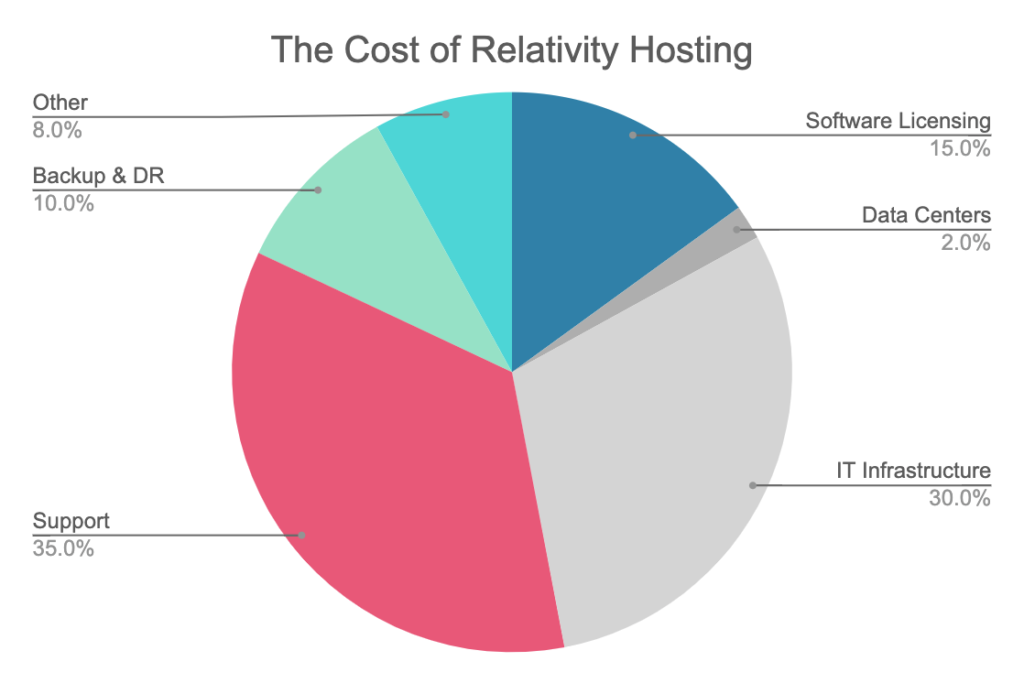Why Is Hosting Data in Relativity So Expensive?
The cost of doing business may surprise you
As the price for cloud-based storage plummets on platforms like AWS and Google, it’s surprising that hosting vendors specializing in eDiscovery—and specifically those hosting data in Relativity—continue to charge so much.
As it turns out, it’s not a racket. It’s not just a bunch of greedy vendors soaking clients for all they’re worth. In fact, there are a lot of costs—some of which aren’t obvious— that contribute to the hefty price tag. The following is a behind-the-scenes look at hosting in the world of eDiscovery: what it takes, what it costs, and why those per-GB fees are so high.
Two quick notes
Overhead. Keep in mind that hosting vendors have more costs than just those I’m about to share. Sales, marketing, administration, cost of capital, taxes, and dozens more “overhead” costs all contribute to the price clients pay for hosting (those Legal Week parties don’t pay for themselves!). However, these are not factored into this article. I’m focusing on the costs “directly” attributable to Relativity hosting.
Percentages. The specific dollar amounts associated with the cost of hosting fluctuate over time and vary widely based on several factors—factors that are outside the scope of this article. So, in order to avoid repeating the phrase, “it depends,” a million times, I chose not to attach specific dollar figures to individual costs and instead expressed each as a fraction of the overall cost attributable to hosting.
1. Software Licensing
First and foremost, Relativity is expensive to license—as it should be. It takes a lot to develop, maintain, and support a very sophisticated platform like Relativity. The premium price tag can only be justified by a premium solution which, in my opinion, they deliver.
That said, most vendors “pass through” the cost of licensing Relativity to their clients in the form of a monthly user fee. This “pass through” gives clients the impression that the user fee covers the software licensing costs for the vendor, but that’s not actually the case because Relativity isn’t the only software license required to operate a Relativity instance.
SQL, complementary eDiscovery applications like Brainspace, Microsoft Office, and plenty more (processing tools, file transfer tools, antivirus programs, intrusion detection, the list goes on) must be licensed to make Relativity work like it’s supposed to.
And…each of these “supporting” applications has its own requirements for hardware, maintenance, and support—all of which adds up.

15%. While Relativity makes most of its money from monthly user fees, hosting vendors recover the costs for all other supporting software in the monthly hosting fee.
2. Data Centers
The data center is a big, physical building (think Costco on steroids) that’s built specifically for housing thousands of refrigerator-sized cages. Each cage is designed to hold a stack of high-powered servers connected to each other and to the outside world via fiber-optic cables.
Data centers (good ones at least) are protected 24/7 by armed security personnel and have incredibly robust plans for power and climate control. Robust in terms of sophistication, but more importantly, in terms of redundancy. End users—whether YouTube or Relativity users—have very little tolerance for downtime and it’s the data center’s job to make sure that any real-world problems (like power outages) don’t impact the user’s virtual world.

2%. Companies pay up to $3,000 per square foot per month for top-tier data centers, making it some of the most expensive real estate in the world.
3. IT Infrastructure
Next, the cost of servers, or more broadly, the IT infrastructure that supports the end user’s experience.
Every industry has different infrastructure requirements based on what it’s trying to accomplish. In eDiscovery, we need high-performing storage arrays capable of quickly reading and writing millions of small files (tiff, jpg, msg, txt).
Because “millions of small files” is somewhat unique to eDiscovery, the servers required to meet our needs aren’t standard, nor are they available “off the shelf.” Unfortunately, we simply can’t use generic storage solutions because our tasks (processing, data loading, and productions) put an extraordinary strain on typical file servers. Add to that, the requirements for instant scalability, real-time backup, and support for outdated software applications, and you have a recipe for expensive.
Bottom line: hosting costs for eDiscovery are extraordinary because we use special hardware, configured for a special purpose. And if there’s one thing custom-built servers are not, it’s cheap.

30%. eDiscovery equipment is purpose-built, high-end, and expensive. Plus, it needs to be replaced every 3-5 years.
4. IT, Security, and Application Support Teams
Front-line support (project management or ‘tech time’) is just the tip of the iceberg when it comes to supporting a Relativity instance. Although many vendors charge hourly rates for their PM services, those fees are tied to specific projects—not the ongoing maintenance and support that takes place behind the scenes.
Consider just some of the skills necessary to run a basic Relativity instance: SQL administration and scripting, Relativity infrastructure and administration, data load balancing, and system administration (the people who troubleshoot, perform maintenance and upgrades, and track down solutions for bugs). Cybersecurity experts are also necessary. Ten years ago, a security team was an afterthought, but due to an increase in hacking and thus, daily defense management, they’re now required. Experts like this come at a price—if you can find them.

35%. Keeping data safe and available is non-negotiable, which is why behind-the-scenes support makes up one of the largest costs associated with hosting. Although these people are usually out of sight, their salaries show up in the hosting fee.
5. Backup & Disaster Recovery
Clients have a low tolerance for sluggish performance and zero tolerance for downtime or data loss. Therefore, hosting vendors implement expensive “redundancy” plans, so if anything goes wrong, the system will immediately fail over to the backup.
Most people are familiar with the need for backups and disaster recovery plans but many fail to consider that it’s not just client data getting copied—it’s the entire environment. Web servers, SQL servers, and dozens of other network resources have to be mirrored in a secondary geographic location.
VM snapshots are performed once every hour for three days and once per day for three weeks (more if designated critical). Offering this level of data support would skyrocket the cost of AWS-type solutions.
Even if these backups (and backups of backups) are never deployed, they still need to be maintained just in case. And if you’re thinking of cutting corners, heavy-handed service level agreements (SLAs) carry financial penalties for even brief service interruptions, forcing everyone to err on the safe side. The ultra-safe side.
So, in order to meet client expectations for uptime and redundancy, petabytes of data are alive today, waiting in the wings to spring into action.

10%. The “hosted size” that clients see on their invoice is only a fraction of the data that is actually stored on disk for them. Backup and disaster recovery plans are costly to maintain even though they remain largely unseen.
6. Other Stuff
Carrying Receivables. For various reasons that I don’t completely understand, very few law firms pay invoices quickly. Maybe it’s because they work on a contingency basis, or they’re waiting for insurance companies to come through, or maybe they’re just stingy. As a result, being in the Relativity hosting business means that you’re also in the finance business.
The data center, Relativity licenses, hardware vendors, employees, and virtually every other cost else described in this article must be paid upfront, months before payment is expected from the client. And considering most vendors don’t charge interest on past-due invoices, it’s safe to assume that the cost of carrying this much A/R is factored into the hosting fee.
Ultimately, slow-paying clients pay more than fast-paying ones. Think I’m wrong? Ask your hosting vendor if they’re willing to lower your rate in exchange for pre-payment and see what happens.
Security & Compliance Certifications. Each of the 100 checkboxes on a security questionnaire has real costs associated with them. Third-party audits, penetration tests, ongoing training for employees, and fees paid to certifying bodies top the list of costs associated with achieving high-level security certifications.
Although many of the certifications like ISO27001 are “table stakes” these days, there are very real costs with achieving—and then working within—these frameworks.
For example, SOC 2 Type II is approximately $150,000 for a small organization with annual maintenance of up to $30,000. And FedRAMP? Don’t get me started.
Threat Detection. All day, every day, bad actors are trying to break into networks all over the world. There isn’t anything specifically unique about eDiscovery in that regard, but the consequences of a data breach for an organization hosting the sensitive data caught up in litigation or investigations are particularly significant. In addition to internal systems that detect threats, most top-tier hosting providers have 24/7 threat monitoring by a third party. This second pair of eyes can cost anywhere from $2,500 to $20,000 each month.
Insurance. If something goes wrong, there will be hell to pay. Or, you can just pay a little bit of hell every month in the form of insurance. Specifically, Errors and Omissions insurance with Cyber Liability that covers data breaches and cyberattacks. The greater your risk profile, the more you pay for insurance. As you can imagine, eDiscovery hosting vendors have high-risk profiles.

8%. Although these miscellaneous costs may not seem like much individually, they add up, and ultimately contribute to the price clients pay.
How It All Stacks Up
In “The Fall 2022 eDiscovery Total Cost of Ownership Survey,” 50 respondents (primarily in operational management and leadership positions) frequently reported that they did not know their spend for the components laid out in this article.
It’s difficult to determine actual spend for managing eDiscovery in-house as it varies based on size, priorities, location. But one thing that’s easy to say, is that many people aren’t sure what they’re spending OR, as we’ve seen, will misattribute the category of their spending.
In this chart, you can see how it all adds up. As you would imagine, the cost of servers and other network architecture counts for a lot, and there are a variety of costs involved that are mostly unseen by the folks footing the bill.

Although I’ve run hosting businesses for a while and have quite a bit of insight into the economics of it all, I can’t speak for everyone. It’s likely that every vendor’s division of hosting costs will look a bit different; some may have costs not mentioned here, while others may have outsized costs based on their business model.
In other words, quite a bit of this “depends,” so take the percentages listed here with a grain of salt. This isn’t a research paper, it’s simply a response to every LSP’s favorite question, “Why is this hosting fee so high?”
Well, now you know.

Brandon Law
Chief Executive Officer